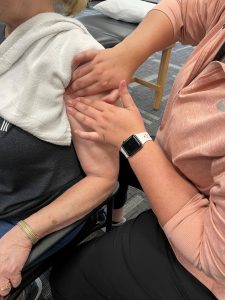The Powerful Role of Physical Therapy After a Breast Cancer Diagnosis
October 7, 2025

A breast cancer diagnosis is life-changing. While much of the focus understandably falls on treatments like surgery, chemotherapy, and radiation, there’s another key part of recovery that’s often overlooked — physical therapy.
Whether you’re newly diagnosed, currently in treatment, or in recovery, physical therapy (PT) can play a powerful role in helping you regain strength, mobility, and confidence. Let’s explore how.
1. Restoring Mobility and Strength
After surgery such as a lumpectomy or mastectomy, it’s common to experience tightness, pain, and limited range of motion — especially in the shoulders and chest. Radiation therapy can also cause tissue stiffness.
A physical therapist can help:
-
Improve shoulder and arm movement
-
Reduce tightness and scar tissue
-
Guide safe, gentle exercises tailored to your stage of recovery
-
Prevent long-term mobility issues
By working with a PT early, many patients avoid chronic stiffness or pain that might otherwise linger for years.
2. Managing Lymphedema
Lymphedema is swelling caused by a buildup of lymph fluid, often occurring when lymph nodes are removed or damaged during cancer treatment.
Physical therapists trained in lymphedema management can:
-
Teach you lymphatic drainage techniques
-
Apply specialized compression garments or bandaging
-
Guide safe exercise to reduce swelling
-
Monitor and catch symptoms early
Early intervention can make a dramatic difference in preventing or minimizing lymphedema.
3. Reducing Fatigue
Cancer-related fatigue is one of the most common and frustrating side effects of treatment. It can linger for months or even years. While rest is important, movement is medicine.
A physical therapist can design a safe, personalized exercise plan that gently increases energy and stamina over time — without overdoing it. Regular movement has been shown to:
-
Reduce fatigue
-
Improve sleep
-
Boost mood and mental clarity
4. Improving Posture and Body Awareness
After surgery or radiation, many people unconsciously guard or protect the affected side, leading to poor posture and muscle imbalances. Over time, this can cause back, neck, or shoulder pain.
Physical therapy helps retrain your posture, improve body mechanics, and build awareness of how you move. You’ll learn how to:
-
Sit, stand, and walk comfortably
-
Rebalance your muscles
-
Carry and move objects safely
This can also help you feel more confident in your body after treatment.
5. Supporting Emotional Recovery
The physical and emotional toll of breast cancer can’t be separated. Exercise — even in gentle forms — releases endorphins, which help ease anxiety and depression. Simply working with a compassionate therapist who understands your journey can be empowering.
You’re not just rebuilding your body — you’re reclaiming your life.
6. Long-Term Wellness and Prevention
Physical therapy isn’t just about recovery — it’s about thriving. As you transition from treatment to survivorship, PT can help you:
-
Return to favorite activities
-
Build a sustainable fitness routine
-
Manage long-term effects of treatment
-
Reduce the risk of recurrence through active lifestyle changes
Final Thoughts
Physical therapy is a vital — and often underused — part of breast cancer care. Whether you’re recovering from surgery, managing side effects, or simply looking to feel strong again, a physical therapist can be a key ally on your journey.
You don’t have to do this alone. Ask your oncology team for a referral to a physical therapist experienced in cancer rehabilitation. The road to recovery may be long, but every step forward is a victory — and physical therapy can help you take those steps with strength and confidence.
